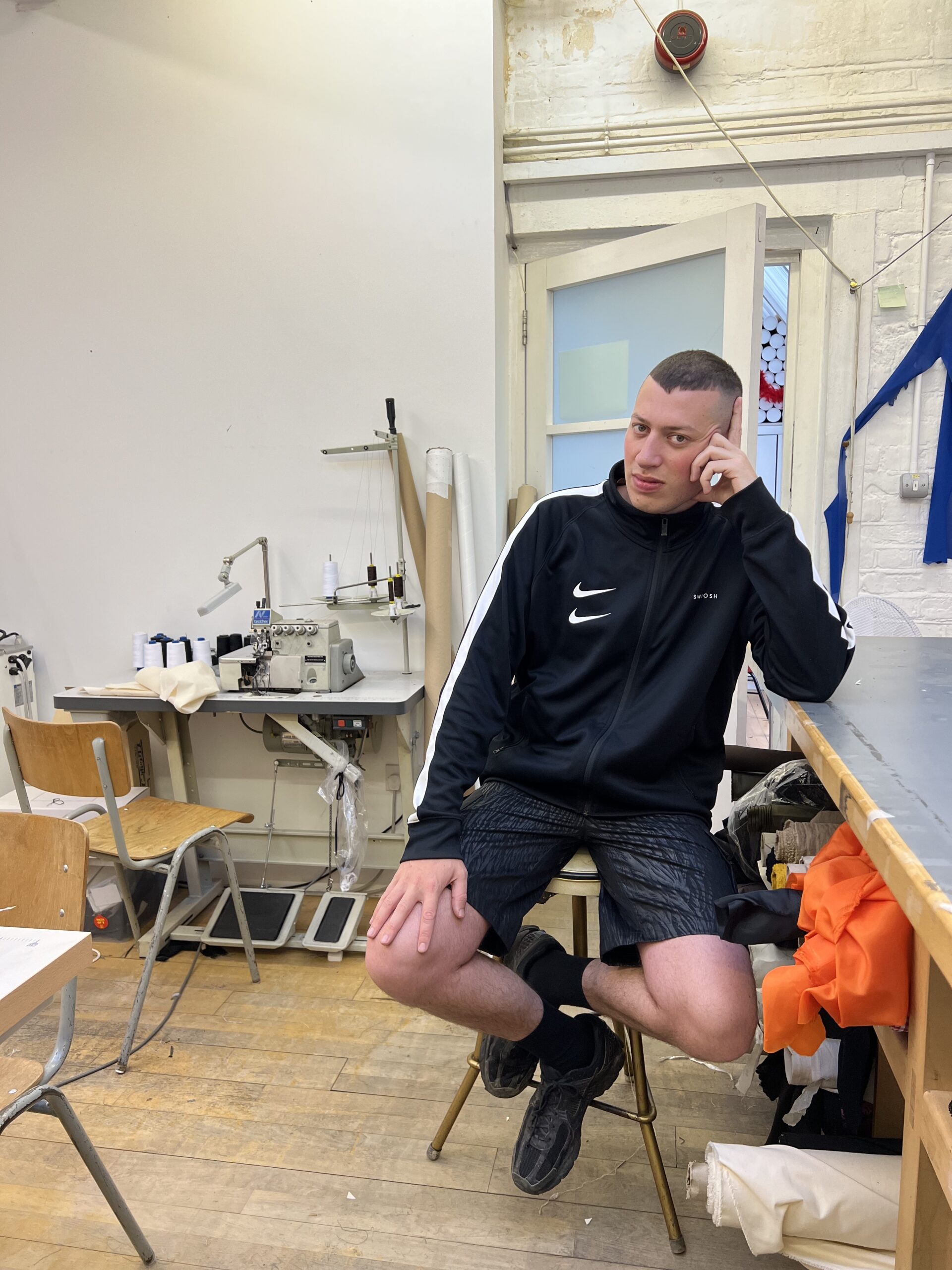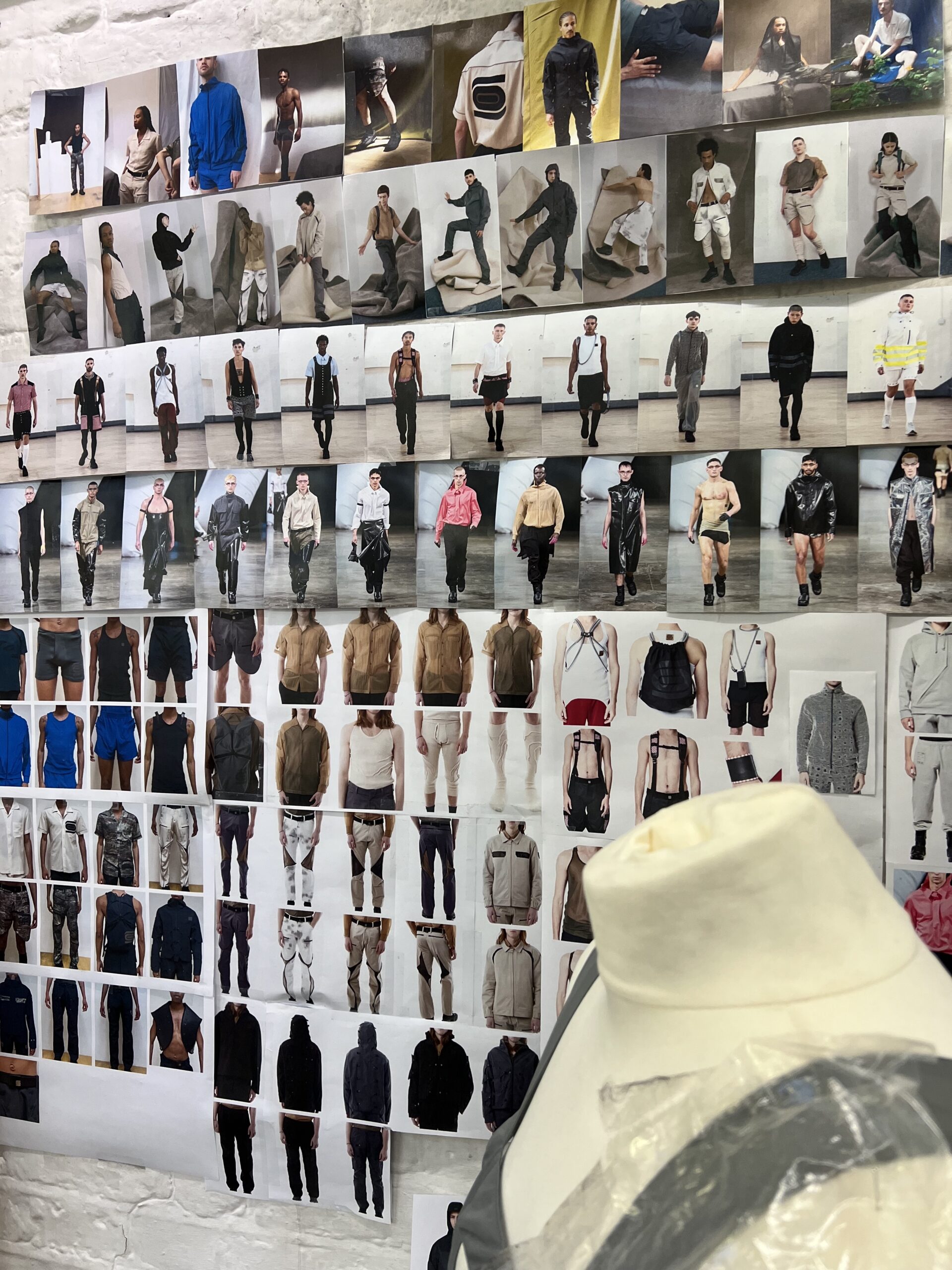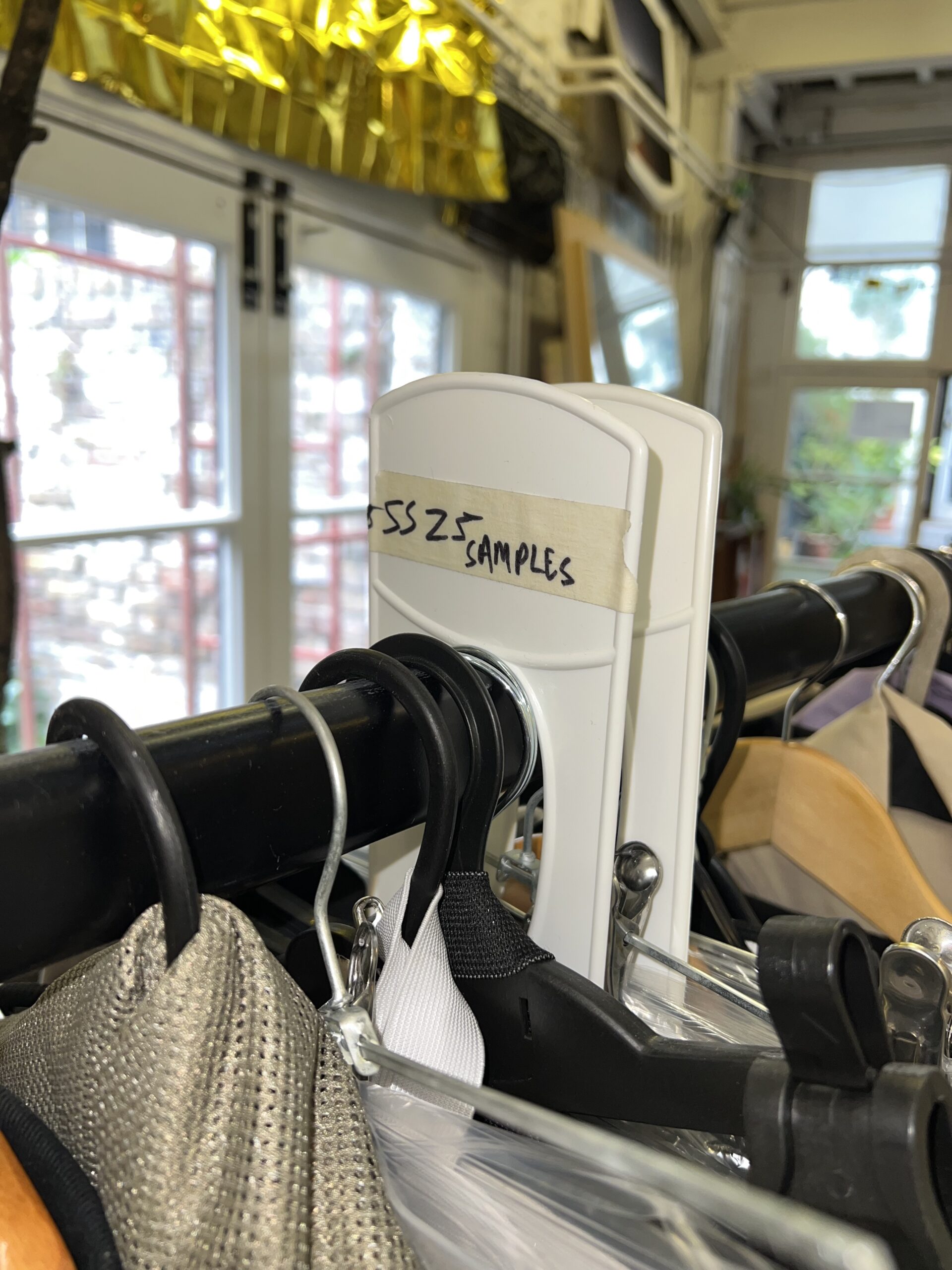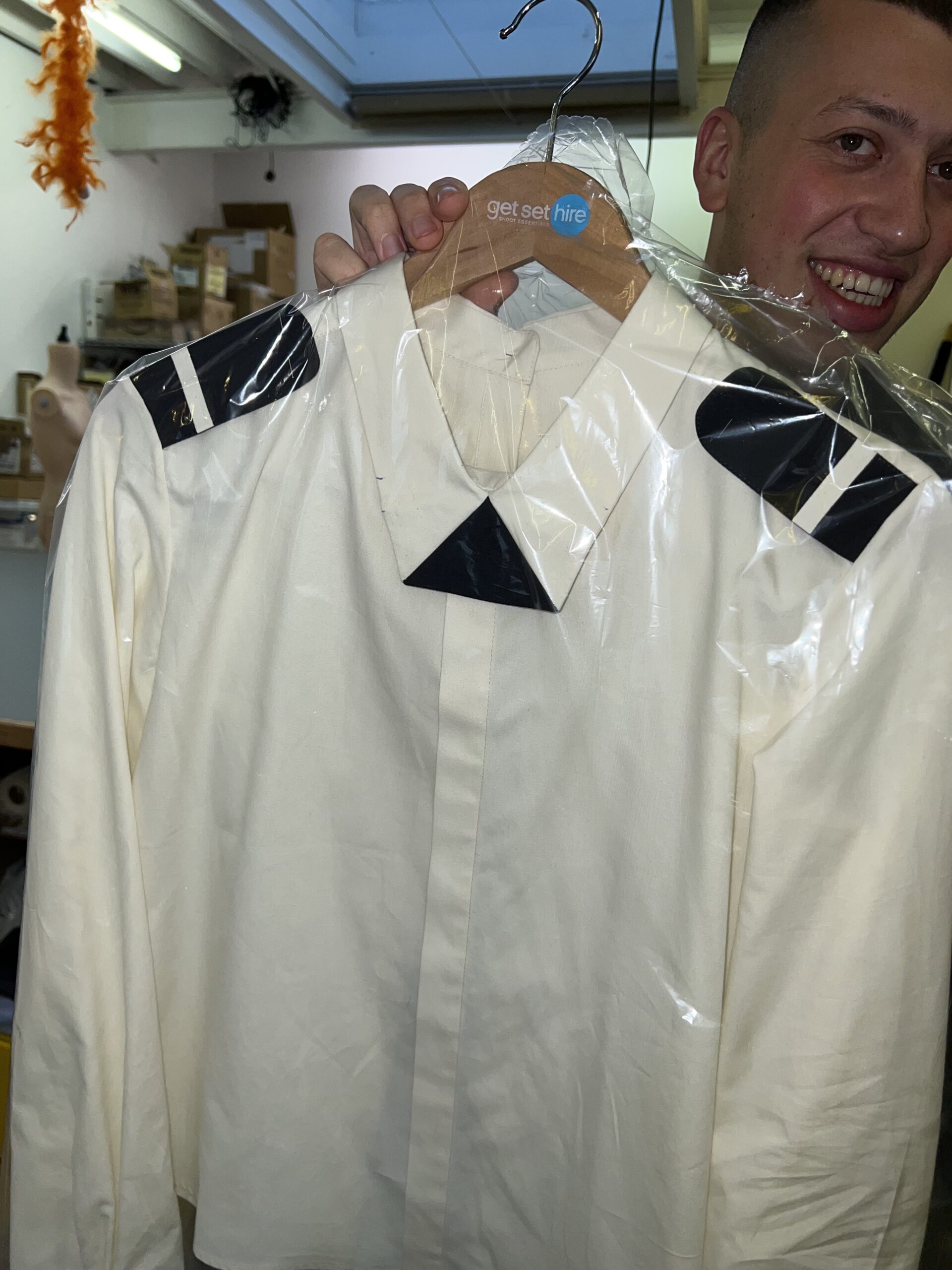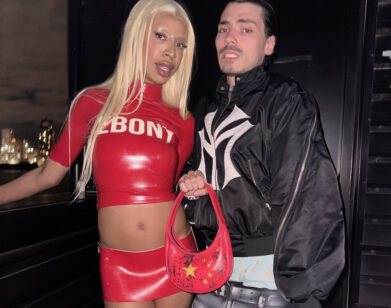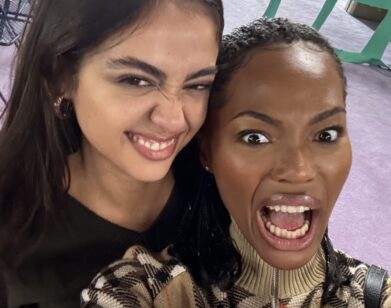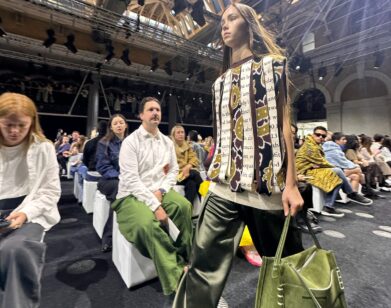LFW
“I Want to Carve Out a Place in Culture”: Behind the Scenes of Olly Shinder SS25
When I met Olly Shinder, founder of his eponymous menswear brand, he seemed calm in the eye of the Fashion Week storm. Fashion East, the London-based incubator hosting his SS25 show, has nurtured the likes of Jonathan Anderson and Mowalola Ogunlesi, so being one of its alumni comes with considerable pressure.
A few days before the show, we’re in his studio in Farringdon, featuring mood boards that reference Frank Ocean in Nasty Pig and stills from Black Narcissus next to clothing racks of what will eventually become his latest collection. Shinder’s clothes have always winked at the sartorial codes of masculinity, merging workwear with latex or hinting at fetishism. When we spoke two weeks before the show, he admits he’s a bit all over the place. “This week I’ve been going mad,” he told me, “but remembering how I felt before my last collection gave me a little bit of stability.” With one of the buzziest shows on the LFW schedule, it appears to be working for him.
———
BEN FREEMAN: All right. Where are we right now?
OLLY SHINDER: We are in my studio.
FREEMAN: How long have you been here?
SHINDER: Since 2021. It was still COVID times when I moved in here. It’s actually the back of a friend’s house. I thought that I needed a backup option if the university closed, a space to work in, and somehow it carried on. It’s just really difficult finding a space in London. It’s not the best business model for a designer, let’s put it like that.
FREEMAN: Totally. Did you grow up in London?
SHINDER: Mm-hmm.
FREEMAN: Whereabouts?
SHINDER: North London.
FREEMAN: Do you think you’ll stick here? I mean, it looks like you’ve got a pretty good setup for the back of a friend’s house.
SHINDER: It is a really good setup. He’s definitely said that I could use it at least for one more year, but we’re taking it as it goes. I mean, there’s not an infinite time, but I’m just holding in there and seeing what happens with the brand. Things have moved pretty quickly over the last couple of years.
FREEMAN: I can imagine that it’s probably a bit difficult to step back and be like, “Where is this going?”
SHINDER: The moment I start having that thought, then there’s another show. You’re rushing to make that collection happen. I think it’s quite difficult to judge my emotions in a rational way. I feel like I’m a bit all over the place.
FREEMAN: As a young designer, do you feel the pressure to keep the ball rolling as much as you can?
SHINDER: I’ve thought about what happens if you skip a season. It does play on my mind. But two things have kind of put me off doing it. One, what if your assistant has to find another job and then you have to do the really difficult groundwork of finding a team again? And then the second one is, I don’t know how productive I am when I don’t have deadlines. I can’t just suddenly say, “Okay, this six months, this is all going to happen. I’m going to shift this.” I had a month of downtime between the end of June and July, and I wanted to use it to be productive. I had a few conversations, but I can’t really say much came from that. I kind of have a feeling that if I took a season off, it would be a similar thing. Unless I have a really clear idea of what I want to do in those six months off, I think it’s not the right time.
FREEMAN: In that month that you had off, what did you do?
SHINDER: A lot of failed experiments. I was trying to bring in some womenswear pieces into the collection. I was also kind of getting to know the team that’s helping out with the show.
FREEMAN: How are you feeling about the show?
SHINDER: A little bit all over the place, to be honest. This week I’ve been going mad, but remembering how I felt before my last collection gave me a little bit of stability. I remember the whole time completely freaking out and finding it so hard, but I also feel it’s the best body of work that I’ve put out so far. I need to try and hold on to that. Are things okay the way they are right now? Or are we actually in a really screwed situation? I don’t know.
FREEMAN: I guess you’ll find out. That’s so interesting that you were nervous about the last collection because it was probably my favorite of yours. It was probably your sexiest collection. Are there any motifs from that collection coming through into this one? Or is it a new body of work?
SHINDER: Honestly, right now, I don’t have much direction. So far, a lot of the pieces are quite covered up. Having done the sales collection in June, it meant that a lot of the pieces were long sleeve or baggy. Even though they were maybe sexy in my mind, they weren’t as overtly sexy as the last collection. Also, the fabrics. There hasn’t been latex and rubbers in the same way. Maybe I am a little bit reacting to the last collection. I liked putting latex on the catwalk, but I also don’t know if I really want to be a latex brand. I think it will end up being some delicate balance that hopefully is beautiful.
FREEMAN: I’m sure it will be. In terms of the casting of your shows, I go out quite a lot in London, and I recognize some of the queer guys who are knocking around your shows. Is there an Olly Shinder man that you envision and you’re casting?
SHINDER: I feel like it’s kind of an extension of myself, a fantasy of myself, maybe who I’d be if I wasn’t doing this or who I was when I was 19. But I think it changes. That question is always quite difficult: “Who is the man?” I think it is somehow an expression of my thoughts, of my life, what I see, what I find interesting, what I react to, who I would want to put out, who I wouldn’t. It has to be people that bring the fantasy to life. And also it’s important to bring these faces in from the clubs and from queer spaces to build an idea of where the brand sits culturally. Just having models and clothes, it’s fine. But I’ve always been keen to have a cultural voice. I love clothes as well. I want to carve out a place in culture, but I also do care a lot about creating pieces that are equally as good as great designers.
FREEMAN: Do you go out much in London?
SHINDER: Honestly, not that much anymore. I used to go out a lot in 2018 and 2019. And then COVID came. And then I went straight into my final year of university, which was really intense. And then I graduated, and it was Monkeypox summer.
FREEMAN: We all remember.
SHINDER: I was too scared to go out.
FREEMAN: I moved to London during Monkeypox summer. At my going away party, I was making out with all my friends. I had a hypochondriac reaction to all the news. Miss that time.
SHINDER: Somehow in London, I think it’s a little bit difficult to find that momentum again, to find that excitement, to really go out and do a full weekend. I mean, I used to be quite committed to spending the whole weekend out, and it was really fun. In London, there’s maybe three parties that I like going to that I feel like I’m definitely going to have a good time. And they don’t happen every weekend. I found myself twiddling my thumbs, being like, “Was that my London summer?” Particularly, I’m not interested in these huge festivals that the UK seems to be so big on. Taking over a park and putting on some huge thing with expensive tickets; I prefer things that are smaller and low-key. I don’t mean sit-down dinner. A club night with a cute group of people, some hot guys, that’s fine for me. It doesn’t need to be made into this huge thing with massive queues and airport security on your way in. Not to slag off Colour Factory, but I just know that I’m going to leave Colour Factory after having an okay to good time and a very low bank balance.
FREEMAN: It’s a mission.
SHINDER: It’s a lot. It feels like businesses that are trying to rinse you and not really give you a good time. Isn’t nightlife meant to be about fun? That’s why I like going to venues that are a bit more messy, a bit more unguarded, a bit more of a ravey feeling. Because I want to feel free when I go out. It’s a release. I don’t feel free in a lot of London venues. But also, where else in the world would I go? Germany seems to be not the place to go anymore. I used to spend a lot of time in Berlin. But since COVID and the war in Israel started, it doesn’t seem to be a place that I would feel particularly free either.
FREEMAN: You’ve had, it seems, a very busy summer also in terms of Billie Eilish wearing head-to-toe Olly Shinder on the cover of Rolling Stone and Hari Nef wearing that iconic sandpit shirt. Do those moments affect you?
SHINDER: The Billie thing was definitely really exciting for me. But do I feel there’s been a shift? Maybe it’s just my personality, but I’m not very good at celebrating things. I’m not very good at looking back. But I wouldn’t necessarily say that the shift from not having Hari and Billie wearing the pieces to having them wearing the pieces has been bigger than things that happened before, like joining a showroom, showing for the first time, selling to shops. But let’s see how things evolve.
FREEMAN: For sure. We don’t have to talk about this, but I’ve been staring at this photo of Frank Ocean wearing the Nasty Pig jumpsuit. Is that a source of inspiration? I mean, that photo is amazing.
SHINDER: I think it was at one point. Maybe subtly. There’s a lot of yellow in the collection. Whether it makes it out on the runway, I have no idea. My thoughts are all a little bit messy. I spend a lot of time pinning up photos and moving them around in a way that can make sense from the chaos.
FREEMAN: There’s a lot of really interesting references here. We’ve got the nuns as well. Is that something you’re exploring?
SHINDER: What’s that amazing film called? Shit. It was filmed in 1940. Black Narcissus. Often, when I see an Insta story or a film or something on the street, I’ll print it out and just sit on it and see: is this going to somehow take a place in the world that you’re creating? Sometimes they just sit up there, and I overlook them, like that Frank Ocean picture. For some reason, that’s been up there, but I actually have no idea why it’s still up there.
FREEMAN: You don’t have the heart to take it down?
SHINDER: Maybe. Or I haven’t fully engaged with it. This board has more images that I don’t really know where they sit yet. Things that I’m interested in but haven’t made sense of just yet.
FREEMAN: Are we able to have a look at the clothes rack?
SHINDER: Sure. This is definitely not the final edit of what’s going to go in the show, but it is pieces that we’ve sold. Things that are going to go in the shop. This is a wet fur print.
FREEMAN: Gorgeous. And the shorts are so nice as well.
SHINDER: The shorts are cute.
FREEMAN: Wow, I love that. Is it the same yellow from the T-shirt?
SHINDER: It’s actually not. It’s a slightly darker one, more of a mustardy color.
FREEMAN: Nice. Is there no latex in this season, do you think?
SHINDER: I really have no idea. These are cute. They’re boy scout shirts.
FREEMAN: Fun. It does feel quite different to the last collection, but I’m into it.
SHINDER: I was thinking about it. Maybe those first couple of collections are really about being like, “This is who I am.” And then you have to go on a journey and explore different things after you’ve laid those foundations down a bit. But I still have to love what I’ve put out there. These are new ideas that we’ve been working on for the show, pieces that are more interesting. Taking my references and trying to, I don’t know, make things that might work or might not work. Turning shorts into skirts, more drapes, trying to put some girls in things as well.
FREEMAN: Do you think releasing a womenswear collection is something that could happen soon?
SHINDER: At the moment, my womenswear feels derivative of the menswear, just more women’s cuts. It doesn’t particularly feel like a whole separate world. I also don’t have the platform to do a women’s show on top of a men’s show. If I was to do women’s, then they would come out with the men on the catwalk. But in terms of how that would sell, I really have no idea and try not to think about that.
FREEMAN: Fair enough.
SHINDER: It’s still very pre-edit. The next two weeks are just about building it up.
FREEMAN: Is it the day before that you’re making those final decisions?
SHINDER: In the last show, I feel like things really came together two or three days before. Day before is a little last minute. I mean, there’s definitely things that are still being done, but I try to have the general idea of what the looks are. Because when you have direction, things take time to happen. Now is the last time that I could, I don’t know, find some vintage goggles on eBay and turn them into masks. Or maybe, if there’s a fabric I need from a different country, this could be my last chance.
FREEMAN: By the time this interview comes out, the show will be finished. What’s the day after look like for you?
SHINDER: I kind of want to go see the new Alien film. I’ve heard it’s good. I’ve got my boyfriend coming to town from Berlin for the show. I think we’ll just probably hang out and be low-key. I’m really sad; I got invited to a Charli XCX concert the night before my show.
FREEMAN: Really? The H&M one?
SHINDER: Yeah.
FREEMAN: I’m still trying to find the plug.
SHINDER: I really wanted to go, but I just know that I can’t do that the night before my show.
FREEMAN: It’s a bit ballsy.
SHINDER: But then on the other hand, I also know that, if I wasn’t doing this brand, I wouldn’t be getting invited. It was kind of a lose-lose. If I had taken a more normal route and gone and got a job, then why would I personally get invited to a Charli XCX concert?
FREEMAN: But hopefully there’s more Charli XCX concerts that don’t fall the day before your show.
SHINDER: I missed the first one as well. Brat summer isn’t coming for me.
FREEMAN: Brat summer’s over. But I guess it would be quite “brat” to go to the concert the day before your show.
SHINDER: Unless some miracle happens, I’m not going. Sorry, Charli.

